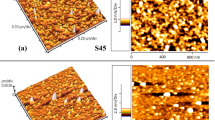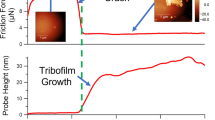Abstract
The evolution of the surface roughness of growing metal or semiconductor thin films provides much needed information about their growth kinetics and corresponding mechanism. While some systems show stages of nucleation, coalescence, and growth, others exhibit varying microstructures for different process conditions. In view of these classifications, we report herein detailed analyses based on atomic force microscopy (AFM) characterization to extract the surface roughness and growth kinetics exponents of relatively low boron-doped diamond (BDD) films by utilizing the analytical power spectral density (PSD) and autocorrelation function (ACF) as mathematical tools. The machining industry has applied PSD for a number of years for tool design and analysis of wear and machined surface quality. Herein, we present similar analyses at the mesoscale to study the surface morphology as well as quality of BDD films grown using the microwave plasma-assisted chemical vapor deposition technique. PSD spectra as a function of boron concentration (in gaseous phase) are compared with those for samples grown without boron. We find that relatively higher boron concentration yields higher amplitudes of the longer-wavelength power spectral lines, with amplitudes decreasing in an exponential or power-law fashion towards shorter wavelengths, determining the roughness exponent (α ≈ 0.16 ± 0.03) and growth exponent (β ≈ 0.54), albeit indirectly. A unique application of the ACF, which is widely used in signal processing, was also applied to one-dimensional or line analyses (i.e., along the x- and y-axes) of AFM images, revealing surface topology datasets with varying boron concentration. Here, the ACF was used to cancel random surface “noise” and identify any spatial periodicity via repetitive ACF peaks or spatially correlated noise. Periodicity at shorter spatial wavelengths was observed for no doping and low doping levels, while smaller correlations were observed for relatively higher boron concentration. These semiquantitative spatial analyses may prove useful in comparing synthesis techniques and varying compositional makeups of diamond films and other technologically important electronic materials. These findings in terms of critical exponents are also correlated with traditional Raman spectroscopy and x-ray diffraction structural properties, thus helping to provide insight into the growth kinetics, albeit in reverse manner.
Similar content being viewed by others
References
R. Kalish, Properties of Diamond, Vol. 6, ed. G. Davies (London: INSPEC, 1994),
J.A. Garrido, C.E. Nebel, M. Stutzmann, E. Gheeraert, N. Casanova, E. Bustarret, and A. Deneuville, Diam. Relat. Mater. 11, 347 (2002).
J.C. Angus, P. Koidl, and S. Domitz, Plasma Deposited Thin Films, ed. J. Mort and F. Jansen (Boca Raton, FL: CRC, 1986),
P.K. Bachmann and R. Messier, Chem. Eng. News 67, 24 (1989).
M.H. Nazare, Properties and Growth of Diamond.EMIS Data Review Series, ed. G. Davies (London: INSPEC, 1994), p. 85.
P. John, Diam. Relat. Mater. 11, 861 (2002).
A.E. Fischer, Y. Show, and G.M. Swain, Anal. Chem. 76, 2553 (2004).
M.A. Rodrigo, P.A. Michaud, I. Duo, M. Panizza, G. Cerisola, and Ch Cominellis, J. Electrochem. Soc. 148, D60 (2001).
E. Kohn, P. Gluche, and M. Adamschik, Diam. Relat. Mater. 8, 934 (1999).
S. Gupta, B.L. Weiss, B.R. Weiner, L. Pilione, A. Badzian, and G. Morell, J. Appl. Phys. 92, 3311 (2002) and references therein.
A.V. Sumant, D.S. Grierson, J.E. Gerbi, J. Birrell, U.D. Lanke, O. Auciello, J.A. Carlisle, and R.W. Carpick, Adv. Mat. 17, 1039 (2005).
A.R. Krauss, O. Auciello, D.M. Gruen, A. Jayatissa, A. Sumant, J. Tucek, D.C. Mancini, N. Moldovan, A. Erdemir, D. Ersoy, M.N. Gardos, H.G. Busmann, E.M. Meyer, and M.Q. Ding, Diam. Relat. Mater. 10, 1952 (2001).
J.B. Cui, J. Robertson, and W.I. Milne, Diam. Relat. Mater. 10, 868 (2001) and references therein.
K.H. Chen, Y.L. Lai, L.C. Chen, J.Y. Wu, and F.J. Kao, Thin Solid Films 270, 143 (1995).
W.A. Yarbrough and R. Messier, Science 247, 688 (1990).
R. Kalish, Diam. Relat. Mater. 10, 1749 (2001).
A.W.S. Williams, E.C. Lightowlers, and A.T. Collins, J.␣Phys. C: Solid State Phys. 3, 1727 (1970).
E. Bustarret, E. Gheeraert, and K. Watanabe, Phys. Stat. Sol. A 199, 9 (2004) and references therein.
R. Viswanathan and M.B. Heaney, Phys. Rev. Lett. 75, 4433 (1995).
K.B. Holt, A.J. Bard, Y. Show, and G.M. Swain, J. Phys. Chem. B 108, 15117 (2004).
H. Assender, V. Bliznyuk, and K. Porfyrakis, Science 297, 973 (2002).
J. Heo and M. Bockrath, Nano Lett. 5, 853 (2005) and references therein.
C. Stali, T. Johnson Jr., and N.J. Pinto, Nano Lett. 4, 859 (2004) and references therein.
Y. Oyanagi, Int. Polym. Sci. Technol. 24, T38 (1997).
D.J. Whitehouse, Meas. Sci. Technol. 8, 955 (1997).
R. Beighley, E. Spedden, K. Sekeroglu, T. Atherton, M.C. Demirel, and C. Staii, Appl. Phys. Lett. 101, 143701 (2012).
D. Ronnow, J. Isidorsson, and G.A. Niklasson, Phys. Rev. 54, 4021 (1996).
For details on roughness and critical exponents analysis, please see M.C. Salvadori, M.G. Silveira, and M. Cattani, Thin Solid Films, 354, 1 (1999).
P.A. Lynn, An Introduction to the Analysis and Processing of Signals (Indianapolis: Howard W. Sams & Co. Inc., 1983), p. 85.
MATLAB (ver 2010b) Signal Processing Toolbox, Spectral Estimation Method.
R. Ramirez, The FFT, Fundamentals and Concepts (London: Prentice-Hall Inc., 1985), pp. 154–155.
D. Morgan, Practical DSP Modeling, Techniques, and Programming in C (New York: Wiley, 1994), p. 332.
O.A. Williams, M. Daenena, J. D’Haen, K. Haenen, J. Maes, V.V. Moshchalkov, M. Nesládek, and D.M. Gruen, Diam. Relat. Mater. 15, 230 (2005).
O.A. Williams, S. Curat, R.B. Jackman, J.E. Gerbi, and D.M. Gruen, Appl. Phys. Lett. 85, 1680 (2004).
P.R. Gill, W. Murray, and M.H. Wright, The Levenberg–Marquardt Method. Practical Optimization, Vol. 4.7.3 (London: Academic Press, 1981), pp. 136–137.
D.M. Gruen, Annu. Rev. Mater. Sci. 29, 211 (1999).
S. Gupta, B.R. Weiner, and G. Morell, J. Mater. Res. 18, 363 (2002) and references therein.
B.D. Cullity, Elements of X-ray diffraction, 2nd ed. (Massachusetts: Addison-Wesley, 1978), pp. 102–111.
M. Yoshikawa, Y. Mori, H. Obata, M. Maegawa, G. Katagiri, H. Ishida, and A. Ishitani, Appl. Phys. Lett. 67, 694 (1995).
S. Prawer and R.J. Nemanich, Phil. Trans. R. Soc. Lond. A 13, 2537 (2004).
J.A. Bennett, J. Wang, Y. Show, and G.M. Swain, J. Electrochem. Soc. 151, E306 (2004).
M. Mermoux, B. Marcus, G.M. Swain, and J.E. Butler, J.␣Phys. Chem. B 106, 10816 (2002).
R.J. Nemanich, J.T. Glass, G. Lucovsky, and R.E. Shroder, J. Vac. Sci. Technol. A 6, 1783 (1988).
D.S. Knight and W.B. White, J. Mater. Res. 4, 385 (1989).
L. Bergman and R.J. Nemanich, J. Appl. Phys. 78, 6709 (1995).
P. Gonon, E. Gheeraert, A. Deneuville, F. Fontaine, L. Abello, and G. Lucazeau, J. Appl. Phys. 78, 7059 (1995).
J.W. Ager III, W. Walukiewicz, M. McMluskey, M.A. Plano, and M.I. Landstrass, Appl. Phys. Lett. 66, 616 (1995).
K. Ushizawa, K. Watanabe, T. Ando, I. Sakaguchi, M. Nishitani-Gamo, Y. Sato, and H. Kanda, Diam. Relat. Mater. 7, 1719 (1998).
P. Pruvost, E. Bustarret, and A. Deneuville, Diam. Relat. Mater. 9, 295 (2000).
P. Pruvost and A. Deneuville, Diam. Relat. Mater. 10, 531 (2001).
S. Prawer, K.W. Nugent, D.N. Jamieson, J.O. Orwa, L.A. Bursill, and J.L. Peng, Chem. Phys. Lett. 332, 93 (2000).
A.C. Ferrari and J. Robertson, Phys. Rev. B 63, 121405 (2001).
A.C. Ferrari and J. Robertson, Phys. Rev. B 61, 14095 (2000).
H. Kuzmany, R. Pfeiffer, N. Salk, and B. Günther, Carbon 42, 911 (2004).
D.M. Gruen, M.A. Krauss, R. Zuiker, C.D. Csencsits, R. Terminello, J.A. Carlisle, I. Jimenez, D.G.J. Sutherland, D.K. Shu, W. Tong, and F. Himpsel, Appl. Phys. Lett. 68, 1640 (1996).
F. Family, J. Phys. A 18, L75 (1985).
M. Kardar, G. Parisi, and Y. Zhang, Phys. Rev. Lett. 56, 889 (1986).
S. Das Sarma and P. Tamborenea, Phys. Rev. Lett. 66, 325 (1991).
A.L. Barabási and H.E. Stanley, Fractal Concepts in Surface Growth (New York: Cambridge University Press, 1995).
E. Medina, T. Hwa, and M. Kardar, Phys. Rev. A 39, 3053 (1989).
T. Hwa, M. Kardar, and M. Paczuski, Phys. Rev. Lett. 66, 441 (1991).
Acknowledgements
G.P.V and S.G. gratefully acknowledge Ryan Giedd and Rishi Patel (CASE, Springfield-Missouri) for providing the AFM instrument used in this study and for technical assistance in corresponding measurements, respectively. S.G. would also like to acknowledge Olivier Williams (then at IMEC, Belgium) for providing the BDD samples used in this study and discussing growth-related studies.
Author information
Authors and Affiliations
Corresponding author
Additional information
This work was primarily conducted while author S.G. mentored graduate student G.P.V. at Missouri State University–Springfield.
Rights and permissions
About this article
Cite this article
Gupta, S., Vierkant, G.P. Surface Roughness and Critical Exponent Analyses of Boron-Doped Diamond Films Using Atomic Force Microscopy Imaging: Application of Autocorrelation and Power Spectral Density Functions. J. Electron. Mater. 43, 3436–3448 (2014). https://doi.org/10.1007/s11664-014-3262-7
Received:
Accepted:
Published:
Issue Date:
DOI: https://doi.org/10.1007/s11664-014-3262-7




